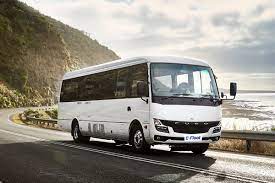The Japanese company has been into making people carriers for decades, and even today, it is one of the leaders in the business. Mitsubishi Rosa is one of its best-known models, preferred for its drivability and reliability. It's been on Australian roads for a while and is among the most popular choices, especially on the used car market.
If you look a little bit closer at many RVs on the road, you will notice that they are actually modified Mitsubishi Rosas. The sturdy design and well-engineered suspension of Mitsubishi Rosa come with a reliable and capable engine that makes it not just a great people carrier but also an excellent platform for motorhome conversion.
Let’s take a closer look and find out what makes this light bus so special.
History of the Mitsubishi Rosa (1960-present)
The history of Mitsubishi Rosa started way back in 1960 when Mitsubishi Heavy Industries launched the original model. A few years later, Mitsubishi merged with Fuso so that latter productions would be known as Mitsubishi Fuso. The original generation was produced until 1973, featuring a design similar to the legendary Mercedes O 319 light bus.
The second generation was also in production for about 13 years, bringing notable improvements in mechanics and aesthetics, including a new front end that shared a lot with other Mitsubishi trucks.
The third generation came in 1986 and was in production until 1997. It brought not just a new styling but an entirely new body, which included some brand-new suspension solutions and an automatic transmission.
Finally, the fourth generation was launched in 1997 and remains in production today. This version is particularly interesting because it was offered in Australia as Mitsubishi Rosa between 2000 and 2005.
Mitsubishi Rosa in Australia (2000-2005)
The Australian version of the Mitsubishi Rosa came as a typical people carrier.
Design & Aesthetics
It was available in three sizes with different number of seats, but the version released in Australia was the longest, with more than 7.7 metres and 25 seats.
There were two grades, the base and the deluxe. Base models were equipped with goodies like air conditioning, exhaust brakes, power steering, radio cassette player etc., while the Deluxe trim included cloth seat covers.
Mechanics
In terms of mechanics, the Mitsubishi Rosa Fuso shared a lot of parts with other light trucks from the company. For the suspension system, the front end featured a double wishbone, coil springs, and double-acting shock absorbers.
The rear axle also featured double-acting shock absorbers in combination with leaf springs and a stabiliser bar. The technical solution for brakes was also pretty conventional, with ventilated discs at the front and classic drum brakes at the rear.
Dimensions
As mentioned, the Australian version of Mitsubishi Rosa was offered only in the longest variant, with 7,730mm total length, 4,550mm in wheelbase, and 180mm ground clearance. The bus was 2,070mm wide and 2,730mm high (ground to ceiling), with a kerb weight of 4,245kg.
In some other markets, this light bus was also available in shorter body variants—with total lengths of 6,250mm and 7,000mm).
The Australian version was equipped with 25 seats.
Mitsubishi Rosa Dimensions:
- Wheelbase: 4550mm
- Overall length: 7730mm
- Overall height: 2630mm
- Overall width: 2070mm
- Ground clearance: 180mm
- Kerb weight: 4245kg
- Turning circle: 15.4m
- Rear track: 1495mm
- Front track: 1655mm
- Front tyre size: 205x85 R16
- Rear tyre size: 205x85 R16
Engine
This generation was offered various petrol and one diesel powertrain for the Australian market.
The lone diesel engine was a 3.9-litre 4-cylinder turbodiesel with plenty of low-end torque (rated at 372Nm and max power of 121kW).
The engine was paired with a 5-speed manual in the base version, while a 4-speed automatic was offered as an option. In 2003, the new 6-speed manual replaced the 5-speed unit, while the automatic gearbox carried on in the same way.
All versions of the light bus feature a decently sized 100L fuel tank.
Mitsubishi Rosa Engine Specs:
- Engine Capacity: 3907cc
- Number of cylinders: 4
- Fuel type: Diesel
- Forced Induction: Turbocharger
- Maximum torque: 372Nm
- Maximum power: 121kW
- Transmission: 4-speed automatic; 5-speed manual (2000-2002); 6-speed manual (2003-2005)
- Fuel tank capacity: 100L
Motorhome Conversion
Over the years, this light bus earned a reputation as one of the most reliable people carriers. Soon enough, enthusiasts realised that this vehicle also features an excellent platform to be a fantastic RV. So, the Mitsubishi Rosa motorhome conversion became a pretty common thing. If you look at today's used car market, you will find a lot of converted models for sale, which hold their value pretty well.
Today, you can even find many companies specialising in this kind of conversion on Rosa and similar models. However, most enthusiasts like to do the whole or most of the conversion themselves. A quick search on the internet will yield blogs and videos showing complete guides for DIY conversions.
Is the Mitsubishi Rosa Bus Reliable?
The Rosa is one of the models that defined the minibus class. Properly designed, with a large and relatively simple engine, this light bus has proved to be one of the class's most reliable units. Moreover, it features a simple and very durable chassis, making it a great choice even today, years after its launch. So far, no bigger Mitsubishi Rosa bus problems have been recorded.
If you plan to replace your old Rosa with something newer, consider advertising Mitsubishi Rosa for sale on our website so you'll find more interested buyers and get a better deal.
By Nebojsa Grmusa

